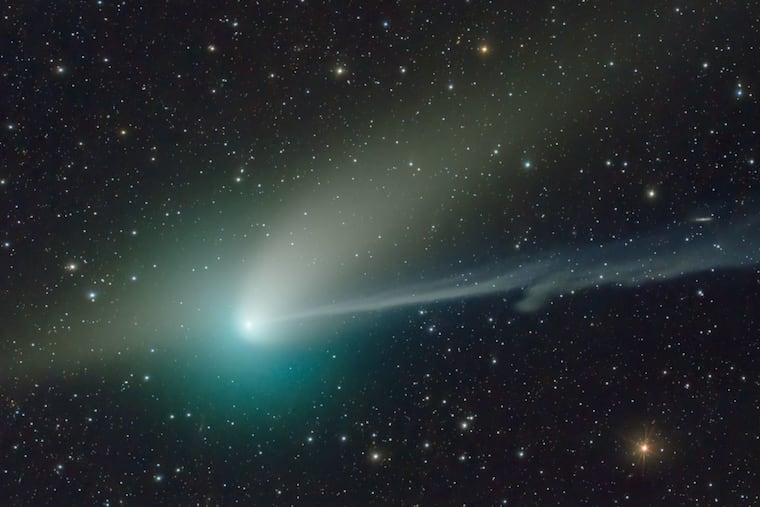An unusual green comet has Eagles fans excited ahead of the NFC championship game
You don't need Eagle-eyed vision to see the comet, just patience and a good pair of binoculars.

A massive blur of green has some Eagles fans excited in advance of Sunday’s NFC championship game against the 49ers.
We speak not of 365-pound left tackle Jordan Mailata, though the sight of him racing to protect quarterback Jalen Hurts is plenty exciting.
This blur is much larger and faster: a greenish-hued comet called C/2022 E3 (ZTF).
Zooming through space at 128,000 miles per hour, the icy ball of rock is passing near Earth for the first time in nearly 50,000 years. And it was discovered with a telescope in enemy territory — California. (Well OK, in southern California, nearly 500 miles from the 49ers’ home base, but surely that must mean something?)
“You could say this Eagles run was written in the stars,” said astronomer John Bochanski, an associate professor at Rider University in Lawrence Township, N.J.
After all, Birds fans already indulge in all sorts of good-luck rituals, whether it’s wearing a favorite commemorative jersey, eating certain foods, or running into a support pillar on the Broad Street line subway platform. Why not look for hope in the heavens?
Football fun aside, the green comet has astronomers intrigued because it offers insight into the early days of the solar system. For the scientific details on the comet, including why it appears green, we spoke to Bochanski and Ed Guinan, a Villanova professor of astronomy and astrophysics.
Also below: how to take advantage of the good conditions for seeing the comet this weekend.
Why the comet is green
Comets are icy balls of rock and dust, left over from the formation of the solar system 4.5 billion years ago.
In this one, the icy exterior contains a substance called diatomic carbon — molecules in which two atoms of carbon are bound to each other. (Sort of like when linebacker Haason Reddick latches onto an opposing quarterback.)
When struck by ultraviolet rays from the sun, these carbon molecules oscillate in such a way that they emit a greenish glow, similar to what happens inside a fluorescent light bulb, Guinan said.
Other comets consist predominantly of substances that emit a bluish glow. Still others can appear golden, when reflecting the sun’s light.
Green comets are not especially rare, but this one is unusual in that it is fairly easy to see from Earth. That’s partly because it is passing fairly close to Earth, by comet standards.
At its closest point, on Wednesday, the comet will be 26.4 million miles away, Bochanski said.
“It’s putting on a pretty good show,” he said.
A comet with staying power
This comet’s green glow is especially pronounced because over the eons, it has lost hardly any of its icy mass, Guinan said.
That’s because it spends very little time near the sun. The comet takes nearly 50,000 years to complete one of its vast, cigar-shaped orbits, looping around the sun at one end, and traveling deep into the chilly, outer edges of the solar system on the other.
That means the icy exterior, which contains the carbon molecules that glow when struck by the sun, has remained fairly stable for billions of years, Guinan said.
“This comet is kind of pure,” he said. “It gives us a look back into the early solar system.”
Other comets pass the sun more frequently, causing their icy contents to melt away, leaving behind a denser nucleus of dark rock.
When the green comet was discovered
Astronomers discovered the green comet in March with the Zwicky Transient Facility camera at the Palomar Observatory in Palomar Mountain, Calif. That’s where the ZTF in the comet’s name comes from.
Within a few months, it was close enough to be photographed by skilled amateur astronomers such as Dan Bartlett, a retired high school science teacher in June Lake, Calif.
He captured the image that accompanies this article, and he happens to have been born in Philadelphia. He’s not a football fan, but he wishes the Eagles well.
Guinan and Bochanski, on the other hand, like football and are fully behind the Birds, even though Bochanski’s job at Rider places him suspiciously close to Giants territory, just north of Trenton. But never fear: He grew up in Gloucester County in South Jersey and went to college at Villanova. He’s an Eagles fan now and forever.
“Comets have always fascinated humanity,” he said. “If this were thousands of years ago, this might have been taken as a sign of bad things about to happen. Because the Birds are doing well and it’s colored green, I like to think it’s a sign of good things to come.”
How to see the comet
Among the first Eagles fans to herald the comet as a hopeful sign was a fan identified only as Anthony, who phoned the show of 94WIP sports radio hosts Joe DeCamara and Jon Ritchie on Monday. He cited an article that he read online.
Seeing it live is a bit trickier. Though this comet is fairly visible as comets go, spotting it still requires a bit of patience and skill, Guinan said.
The best viewing location is a dark spot far from the city, like the Pine Barrens or Valley Forge, on a night with clear skies. This weekend, it can be seen in the northern sky, in between Polaris (the North Star) and the “cup” of the Big Dipper, he said.
“You need to slowly sweep the sky until you see a greenish, fuzzy blur,” he said.
Don’t wait until early February, when the moon becomes full, making the comet harder to see. Better to do it Friday or Saturday night — just in time for a pregame boost of green.
Staff writer Rob Tornoe contributed to this article.